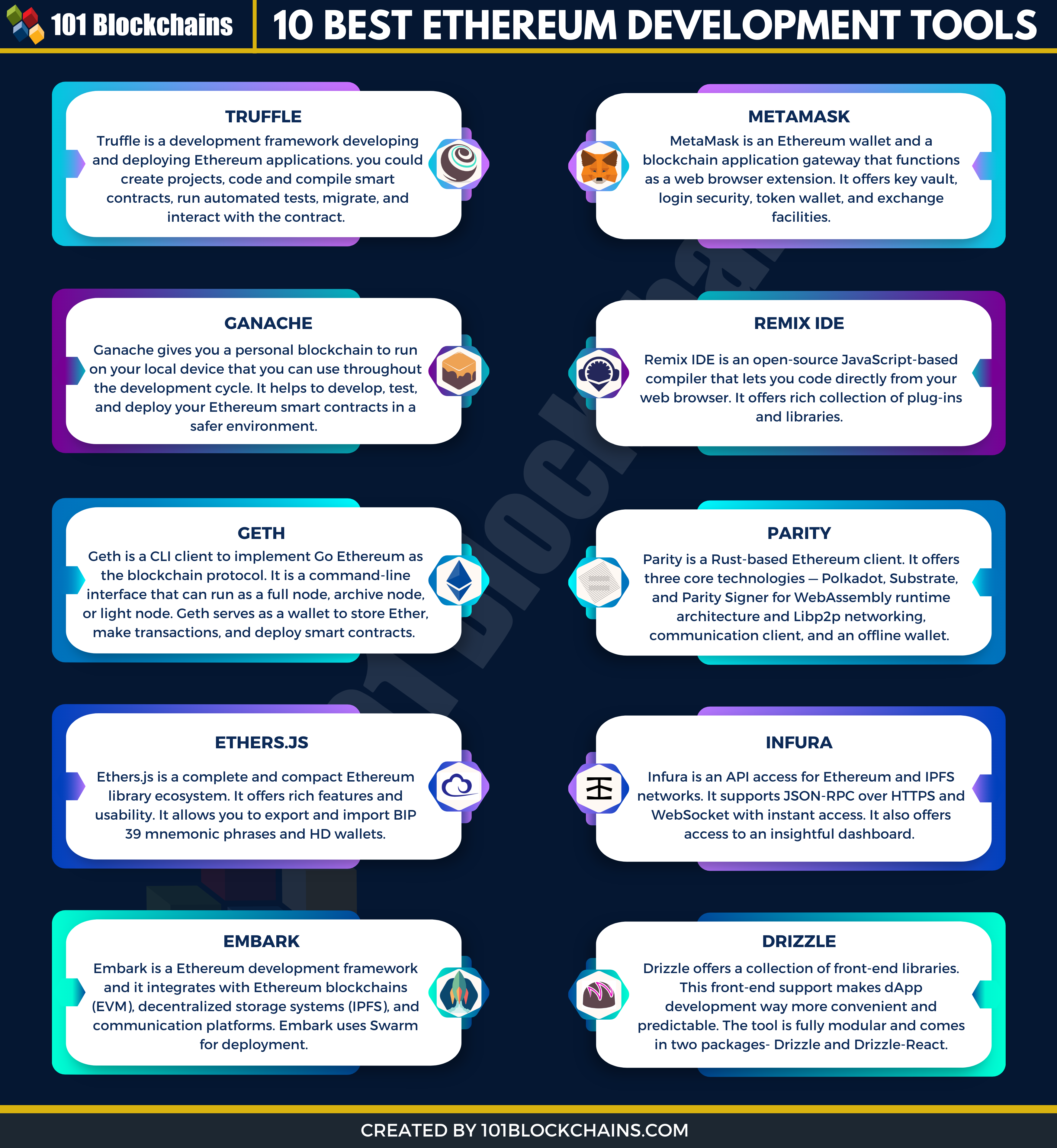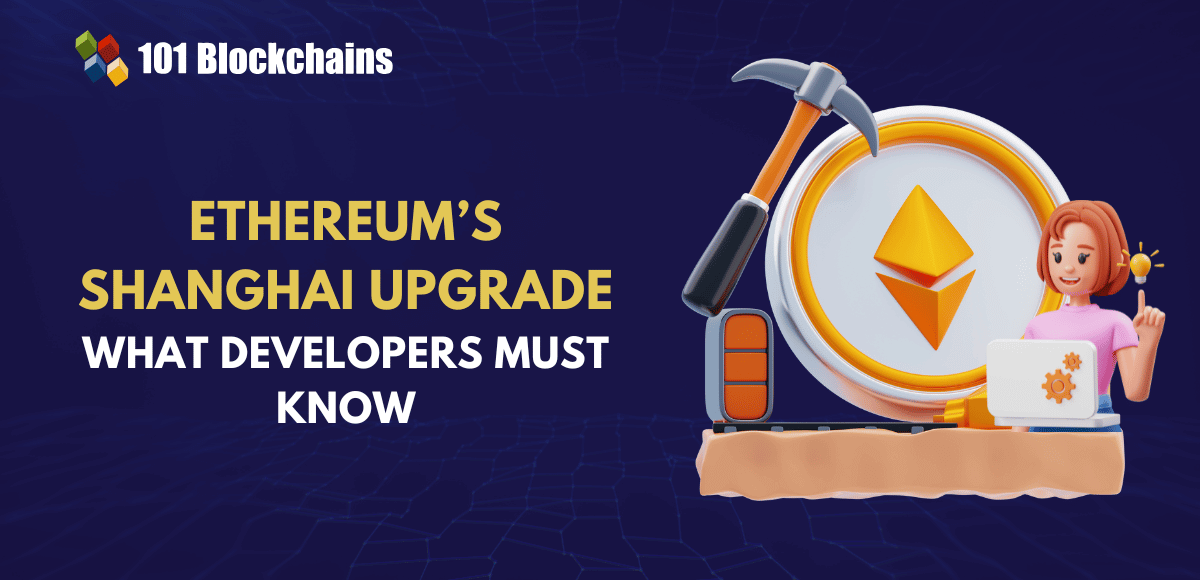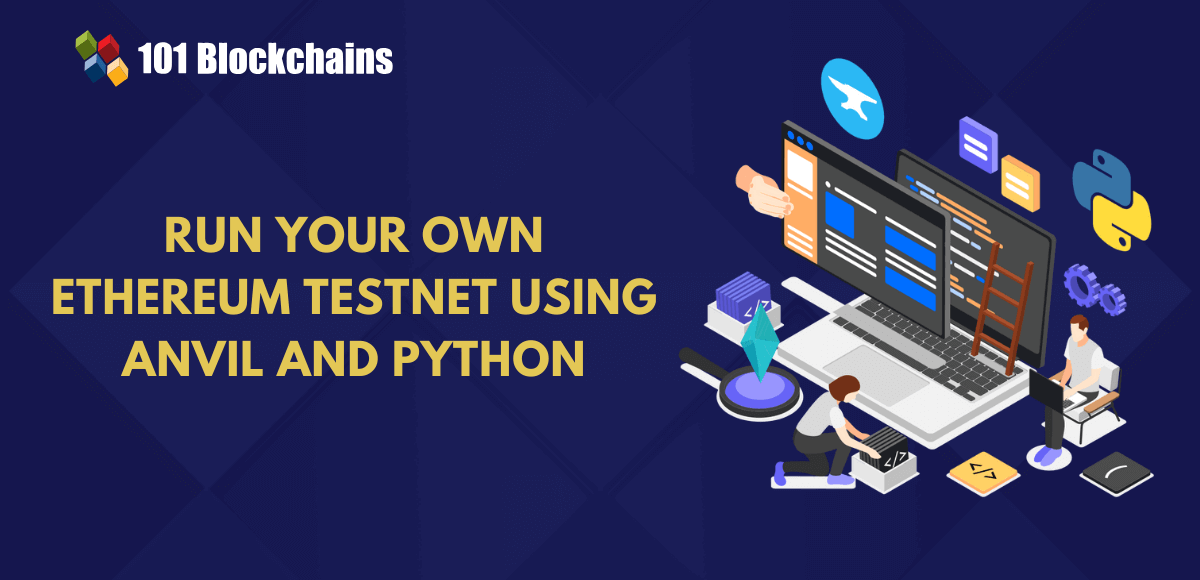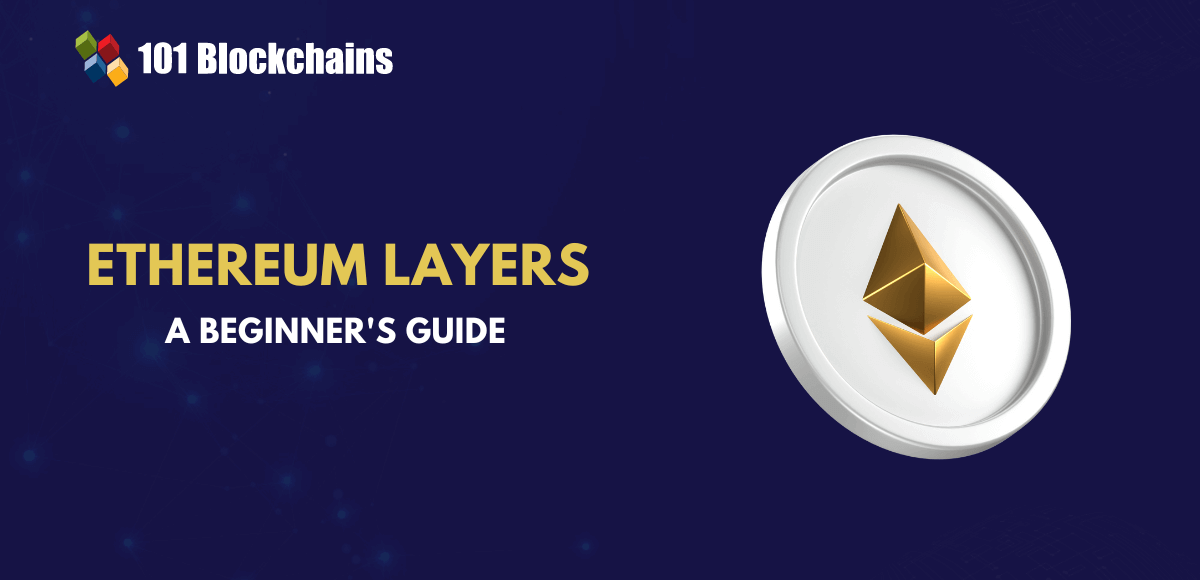Learn how blockchain truly works, master key definitions, and uncover what makes smart contracts so "smart." Dive into the fundamentals, gain valuable insights, and start your blockchain journey today!
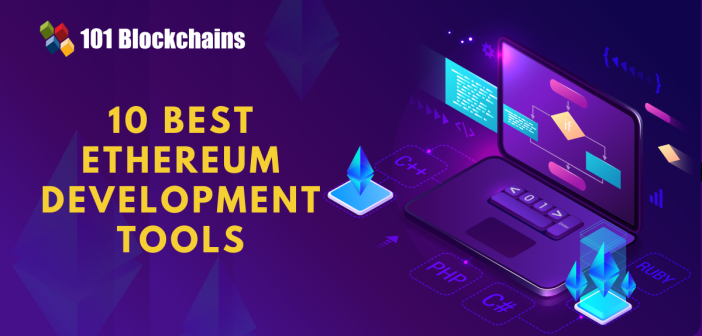
- Ethereum
Hasib Anwar
- on May 28, 2021
10 Best Ethereum Development Tools
This article offers a comprehensive view on the best Ethereum development tools with their core features and probable alternate options.
If you’re embarking on your journey to develop dApps or smart contracts, Ethereum development tools are your best friends. These development tools come with a plethora of functionalities and features that help you automate a lot of your development efforts. As you can guess, your smart contract or dApp development efforts are not limited to coding and deploying only. You’ll need a dependable debugging tool, libraries, an API, a testnet, and many other things. Only with the best Ethereum development tools, you can have a smooth development cycle for your dApp.
That brings us to the topic at hand today — the best Ethereum development tools. This article will take a step-by-step approach to help you with the top Ethereum development tools based on their core purposes.
Excited to build your skill in Ethereum development by leveraging the ethers.js library? Enroll Now in Ethers.Js Blockchain Developer Course!
Best Ethereum Development Tools 2021
Please include attribution to 101blockchains.com with this graphic. <a href='https://101blockchains.com/blockchain-infographics/'> <img src="https://101blockchains.com/wp-content/uploads/2021/05/10-best-ethereum-development-tools.png" alt="10 best ethereum development tools" border='0' /> </a>
The world of blockchain development is changing and it’s changing fast. Every now and then we’re seeing new Ethereum dev tools emerging to the top. At the same time, many Ethereum best tools get deprecated and obsolete. To be on top if your game, you should keep updated with the trends of Ethereum blockchain ecosystem. For example, Mist has been one of the most popular Ethereum development tools. But it got deprecated. Even the Ethereum Wallet faced the same fate. As the community finds better and more advanced best blockchain tools, they simply migrate to them.
Want to learn the basic and advanced concepts of Ethereum? Enroll in our Ethereum Development Fundamentals Course right away!
To keep you updated, here’s the list of the top Ethereum development tools 2021 —
1. Truffle – Development and Deployment Framework

One of the more appealing features of Truffle is that it can perform automated tests both in JavaScript and Solidity. This could help you tremendously if you excel in JavaScript. Plus, Truffle supports both Mocha and Chai test frameworks.
The deployment efforts need your smart contracts to connect to a blockchain network. Truffle offers a personal blockchain that you could store on your local device that doesn’t interact with the Ethereum network. This feature gives you the headroom to tweak your projects as per your needs. Furthermore, it acknowledges that your contracts may update or evolve over time and accepts manageable deployment and migration scripts.
As you can see, Truffle is a robust development framework that considers all sorts of practical deployment scenarios and issues. All of these features surely save an Ethereum developer from a plethora of troubles.
Excited to learn the basic and advanced concepts of ethereum technology? Enroll now in Ethereum Technology Course
2. MetaMask – Token Wallet and dApp Gateway

MetaMask offers key vault, login security, token wallet, and exchange facilities — all in one package. Moreover, users can browse and connect with blockchain applications without jeopardizing their security and privacy.
How is this user-centric tool bring value to the Ethereum developers? Due to the simplistic nature of this app, MetaMask has become the go-to token wallet for both veterans and newcomers. Ethereum developers can showcase their applications to a large audience through MetaMask support. So, if you’re an Ethereum developer aiming to increase user interaction for your distributed app, you need to consider adding MetaMask to your development efforts.
Get familiar with common Ethereum terms with the Ethereum Flashcards
3. Ganache – Personal Blockchain With A Robust Command-Line Tool
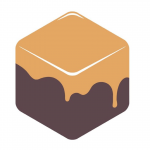
Ganache has two components — Ganache UI and Ganache CLI. Ganache CLI is the command-line tool that you’d be using for Ethereum development. This CLI was previously known as TestRPC. TruffleSuite later acquired TestRPC and gave it a new name — Ganache CLI. How does Ganache CLI work and what does it do?
The command line incorporates ethereum.js for client behavior simulation with all kinds of RPC functionalities. Developers can develop and test their codes to determine what is working and what is not. Ganache UI, on the other hand, serves as the visual interface for the CLI. You could think of it as the built-in block explorer giving you insight and analytics of the internal blockchain.
As writing codes on Ethereum blockchain (mainnet) requires Ether, you should test your dApp in a personal or internal blockchain first for tweaking and troubleshooting. This is why Ganache is one of the most popular Ethereum development tools.
Start learning about second-most-popular blockchain network, Ethereum with World’s first Ethereum Skill Path with quality resources tailored by industry experts Now!
4. Remix IDE – Compiling and Debugging Tool Working on Browsers

Unlike many other Ethereum development tools, Remix takes a direct approach, maybe a bit too direct! Their website directly lands you in the compiler. That’s why many users, especially new developers, complain about the user-friendliness of the website. However, remix outshines others with its rich collection of plug-ins and libraries. Remix Project address these utility tools as — Remix Plugin Engine and Remix Libs, respectively. Another noteworthy feature of Remix IDE is that it debugs your code in real-time while you’re writing them. The straightforward approach for developing smart contracts in Solidity from the browser makes Remix one of the top Ethereum development tools.
Are you aspiring to learn the fundamentals of the Ethereum Virtual Machine and smart contracts’ upgradability? Enroll now in the Advanced Solidity Development Course.
5. Geth – Ethereum CLI Client Based on Go
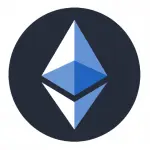
But Geth became a superior option compared to Mist, as it can also mine Ether and serve as a gateway to the Ethereum network through JSON RPC endpoints over HTTP.
These two additional features are extremely lucrative to the developers and caused the obsoletion of Mist. There is another strong reason behind the popularity of Geth — developers want to interact with the Ethereum mainnet and Geth serves that purpose perfectly.
6. Parity – A Rust-based Ethereum Client
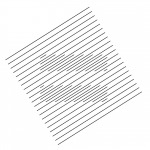
Parity incorporates three core technologies — Polkadot, Substrate, and Parity Signer. Substrate is the blockchain development framework that uses WebAssembly runtime architecture and Libp2p networking. Substrate uses Rust for primary implementation and JavaScript for secondary implementation. So, you’ll be getting speed, reliability, and developability — all in one package.
Polkadot, the second pillar of Parity is the cross-blockchain communication client. You can even transfer data from a public blockchain to a private one — offering a true multi-chain environment. The unique feature of Polkadot is that you can even transfer arbitrary data, apart from tokens, across blockchains. Due to the superior interoperability, you’ll get improved economic and transactional scalability to help you scale Ethereum dApps.
The third pillar of Parity is the Parity Signer. This is an offline wallet that you can use on your mobile. However, most developers using Parity only to the veteran developers as Parity is a bit complicated compared to Go. Plus, the installation process is a hassle. In simpler terms, stick with Geth if you’re a newcomer in the development world and use Parity if you think you’re competent enough.
7. Ethers.js – Ethereum Library Ecosystem

Previously, web3.js was the number one Ethereum library but ethers.js has surpassed it with the rich features and usability. It works perfectly with the popular JSON wallets, such as — Geth, Parity, and Crowdsale. And able to connect to common Ethereum nodes, such as — MetaMask, Infura API, JSON-RPC, Alchemy, or Etherscan.
However, the tiny 104kb size and the completeness make ethers.js the best-in-class library ecosystem. It also has an MIT license for including all dependencies. One of the strongest features of ethers.js is that allows you to export and import BIP 39 mnemonic phrases and HD wallets. Also, ethers.js is always updating the test cases collections. This library is fully TypeScript-ready that definition files and complete TypeScript sources. In short, ethers.js is one of the best Ethereum development tools that you must need for your development efforts.
8. Infura – API
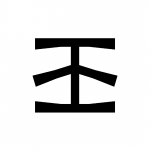
Among all the Ethereum APIs out there, web3.js and Infura API are two of the best options. But Infura beats web3.js in several decision-making criteria. It supports JSON-RPC over HTTPS and WebSocket with instant access. This means you’ll not have to spend your precious time building an infrastructure from the ground up. That’s why many refer to Infura as an Infrastructure-as-a-service. About 60% of all Ethereum apps use Infura API, including — Coinbase Wallet, CryptoKitties, MetaMask, and Compound.
One of the strongest features of Infura API is the access to an insightful dashboard. The dashboard is full of graphical analytics, such as — bandwidth usage, top method calls, etc. If you’re worried about the cost, there’s good news — Infura offers a free account too with the access to Ethereum mainnet and testnets. However, this free account is limited to 100,000 requests/day and up to 3 projects. You need to go for monthly premium subscriptions for better support. So, if you need an API, Infura is one of the best Ethereum development tools.
9. Embark – Development Framework

For decentralized storage, it uses IPFS or Swarm. You can deploy the full application to these two storage systems. It uses EmbarkJS to upload, store, and retrieve data on dApp. Another great feature of Embark is its modularity. You can either develop individual smart contracts or go for building a full-fledged dApp. Integration and extension processes are quite simple as it has a wide collection of plug-ins. Solc, Solium, Etherscan, Remix, Snark — are among the popular plug-ins for Embark.
Then, there is Cockpit — Embark’s web interface for developing, debugging, and deploying dApps. You’ll get a Web UI dashboard, explorer, and a code editor. Overall, Embark is one of the best Ethereum development tools out there for being a flexible development framework with a rich plug-in collection.
Start your blockchain journey Now with the Enterprise Blockchains Fundamentals
10. Drizzle – A Collection of Front-End Libraries

At the heart of this Ethereum dev tool, lies a reactive Ethereum datastore (Redux). This Redux datastore gives you access to more development tools. Plus, Drizzle synchronizes contract data and transaction data.
Another notable thing about Drizzle is that the tool is fully modular. The two packages are — Drizzle and Drizzle-React. Drizzle is the basic package between the two options — serves as a core library. Then, there is Drizzle-React — which connects Drizzle with your existing React applications through DrizzleProvider and drizzleConnect.
Drizzle should be on your Ethereum tools list as it one of the few tools to help you with the front-end development efforts.
Start learning Blockchain with World’s first Blockchain Career Paths with quality resources tailored by industry experts Now!
Final Thoughts
So, that was the comprehensive list of all the best Ethereum development tools for 2021. These should help you out throughout your complete journey of Ethereum application development. Apart from the ten tools that we’ve discussed, you can consider having a peek at — dAppBoard, web3.js, Ethlint (Solium), solc, and OpenZeppelin. Having a strong command of these tools, you can strengthen your career as a blockchain developer. If you’re curious to learn more about Ethereum development, you should take a deeper look at our Ethereum Development Fundamentals Course.
*Disclaimer: The article should not be taken as, and is not intended to provide any investment advice. Claims made in this article do not constitute investment advice and should not be taken as such. 101 Blockchains shall not be responsible for any loss sustained by any person who relies on this article. Do your own research!

